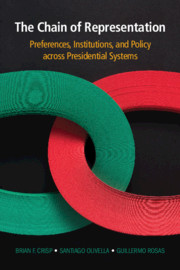Book contents
- Frontmatter
- Contents
- List of Figures
- List of Tables
- Acknowledgements
- Abbreviations
- 1 Studying the Chain of Representation
- 2 Our Solutions to the Challenges of Studying the Chain of Representation
- Part I Stages
- Part II Linkages
- Part III Testing the Chain of Representation
- 9 From Citizens to Policy-Makers
- 10 From Policy-Makers to Policies
- 11 From Citizens to Policies
- 12 A Chain Is Only as Strong as Its Weakest Link
- Appendix Question Wording
- Bibliography
- Author Index
- Subject Index
10 - From Policy-Makers to Policies
from Part III - Testing the Chain of Representation
Published online by Cambridge University Press: 10 January 2020
- Frontmatter
- Contents
- List of Figures
- List of Tables
- Acknowledgements
- Abbreviations
- 1 Studying the Chain of Representation
- 2 Our Solutions to the Challenges of Studying the Chain of Representation
- Part I Stages
- Part II Linkages
- Part III Testing the Chain of Representation
- 9 From Citizens to Policy-Makers
- 10 From Policy-Makers to Policies
- 11 From Citizens to Policies
- 12 A Chain Is Only as Strong as Its Weakest Link
- Appendix Question Wording
- Bibliography
- Author Index
- Subject Index
Summary
Overall, the evidence presented in this chapter suggests that policy-making powers are likely to affect the degree to which policy positions reflect the moods of policy-makers in charge of bringing them about (congruence), but that they are less predictive of the way in which policies change in response to changes in the moods of policy-makers (responsiveness). When they are found to be predictive, PMPs seem to generate a trade-off between the ability to effectively move policy to a position that is more consistent with the preferences of both presidents and legislators, on the one hand, and the ability to adequately represent a variety of interests in the legislature, on the other. The first objective is more likely to be attained when PMPs clearly favor the executive. The latter objective is better achieved when powers are relatively matched across branches. Either through PMPs that give executives an upper hand or through an ability to respond to annually evolving policy orientations, executives seem to hold more sway over the direction of policy than legislators – a fact that is consistent with the relative levels of responsiveness we find in simulation.
- Type
- Chapter
- Information
- The Chain of RepresentationPreferences, Institutions, and Policy across Presidential Systems, pp. 194 - 211Publisher: Cambridge University PressPrint publication year: 2020



